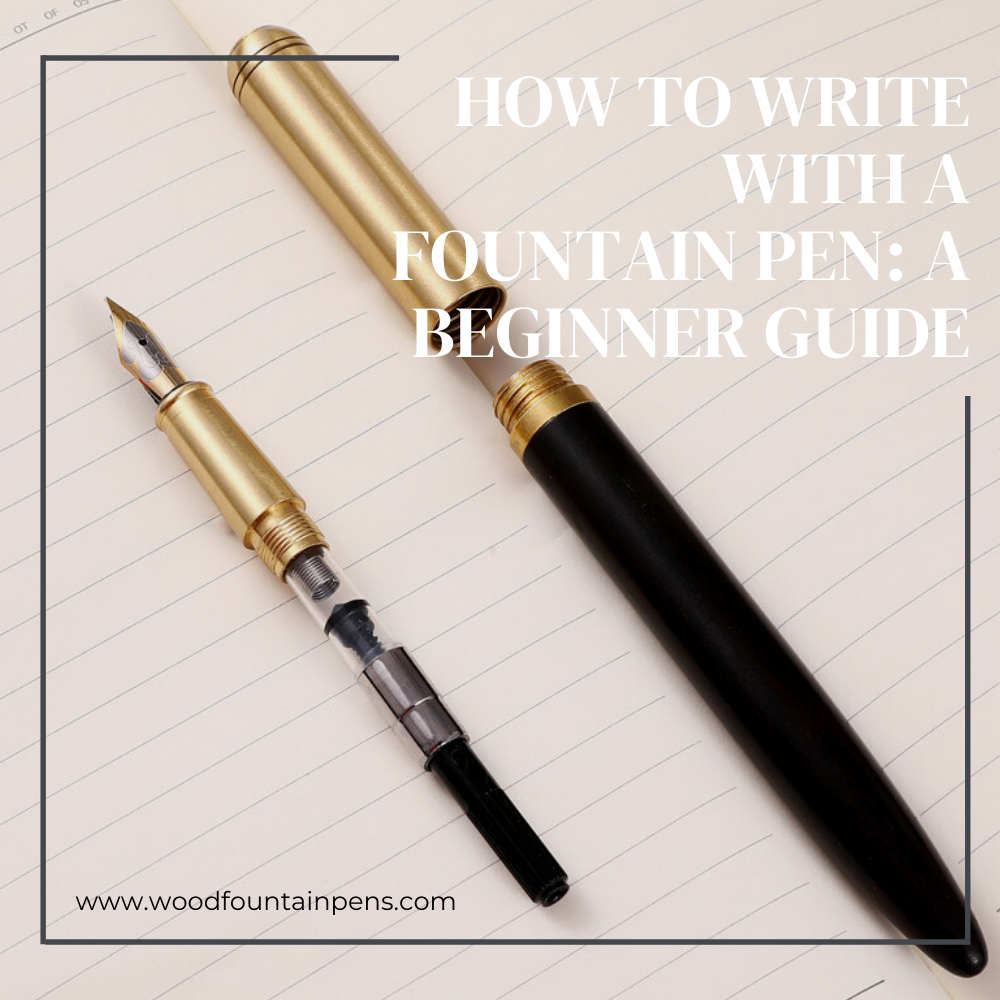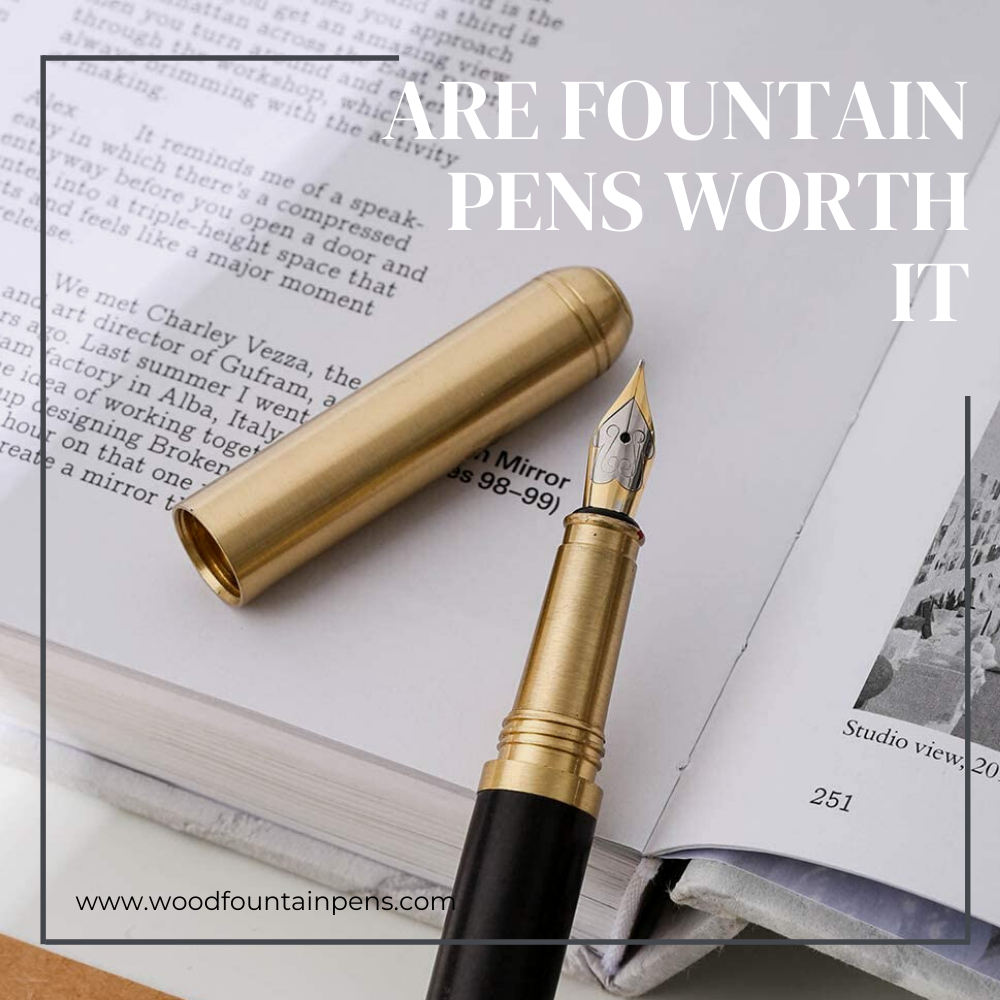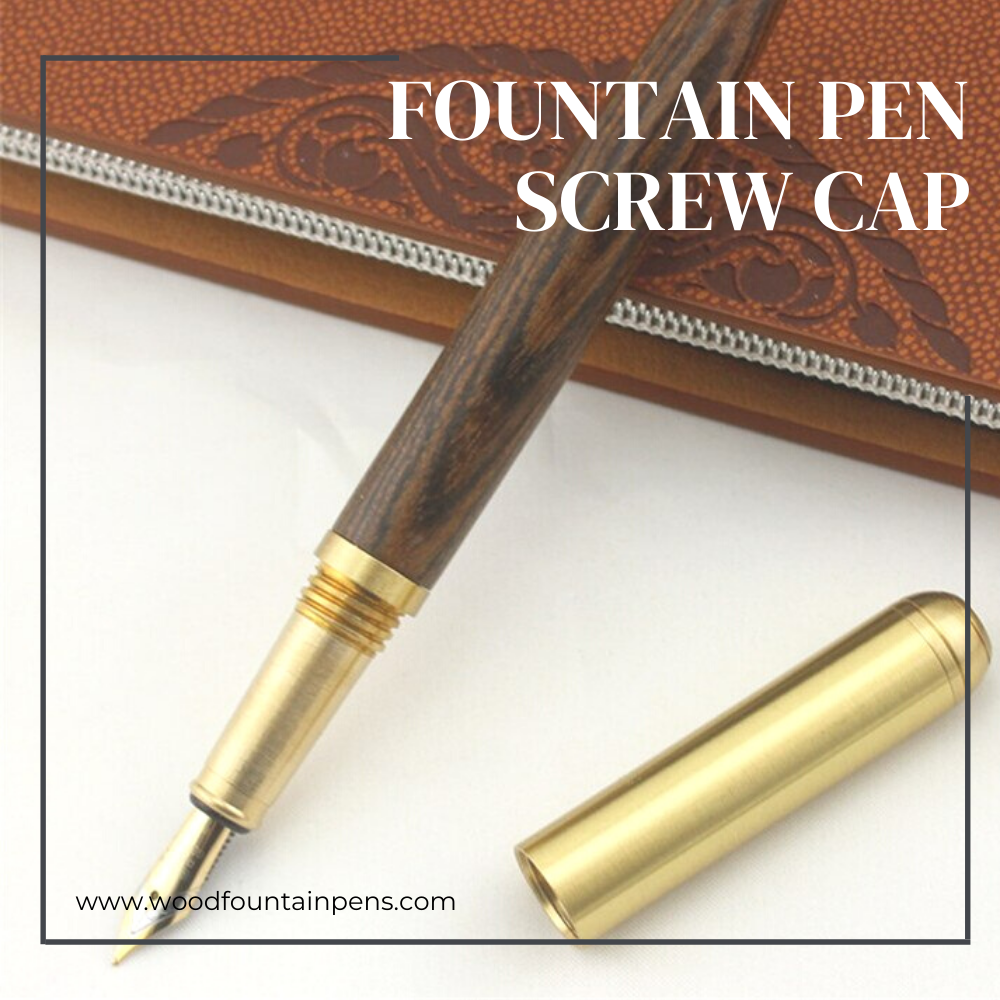
How to Write with a Fountain Pen: A Beginner Guide
Learning how to write with a fountain pen is a work of art and better executed with love. They believe that using a fountain pen is a thing of the past. But this assumption is not entirely true. Recently, there has been an upsurge of people wanting to use these tools again.
But writing is not only its use. Fountain pens are used in art, calligraphy, drawing, sketching, and even decorating jewelry. In this article, we will provide you with an easy guide to write with a fountain pen including how to choose the materials to maximize your writing experience.
Why Use a Fountain Pen?
There are various reasons for writing with a fountain pen. In our opinion, knowing how to use a fountain pen is an art and one should have a deep understanding of it. Some people enjoy the better grip while others enjoy the beautiful handwriting that it produces. For some owning and collecting fountain pens is a form of artistic self-expression. Aside from this, fountain pens are more sustainable and durable compared to traditional ballpoint pens. But no matter why you want one, a fountain pen is an excellent choice if you're looking for something practical and stylish that you can use every day.
Choosing a fountain pen can be intimidating at first because there are so many kinds available. From cartridge pen to eyedropper pen, it's easy to get overwhelmed by the choices out there. However, once you use them, it’s easy to understand why they've been around for so long time.

Basic Materials & Tools - How to Write with a Fountain Pen
If you’re looking for new fountain pens, there are several aspects you should think about before you purchase one.
Size and Width of the Pen
First things first — think about the size of the fountain pen. The size of the pen should be roughly equivalent to the size of your hand. It shouldn't be too long or too short for your hand. Apart from the length, you should also look out for its width. You should always choose a wider pen because they are much easier to hold than regular ones. However, if you find yourself having trouble gripping then you should opt for a slightly narrower writing instrument. Although for some people, wider pens may be uncomfortable to grip and use. There is no “one-size-fits-all” approach for selecting a writing instrument. Just make sure that you are comfortable with the "feel" of the pen when holding it.
Weight of the Pen - How to Write with a Fountain Pen
The next thing you need to think about is the weight of the pen. There are three things that can affect the weight of a fountain pen: the material from which it's made; the amount of ink inside the barrel; and the diameter of the inner chamber. Most of the pens produced today are made out of stainless steel like aluminum, alloy, and gold, but many manufacturers of fountain pens today are using wood, plastic, and other synthetic materials.
Either way, the material used in the material can contribute to the overall weight of the pen. Another thing you should consider when choosing the weight of the pen is the diameter of the inner chamber of the filling mechanism of the pen. Choosing a smaller diameter will hold less ink and allow you to write only a few lines before needing a refill. While a larger diameter can hold more ink it would need a bigger refill.
Like the size, the weight of the pen depends heavily on your preference. But in general, a fountain pen should be able to dispense ink once it touches the writing surface. A heavy pen can cause fatigue and can affect the overall results in handwriting. So choose a pen according to your use. A heavy pen is suited for signature and note-taking while a lighter pen is better for general writing and calligraphy. But again, it depends on your needs it is recommended to try out
The Nib
The third thing you need to consider when choosing a fountain pen is its nib. The nib is the main component of any fountain pen. It determines how well the ink flows onto paper and how smooth the lines are.
The nibs come in three sizes: fine, medium, and broad. Fine nibs can be used for fine details such as handwriting, while broad nibs can be used to create thicker lines and more bold strokes while medium nibs are somewhere in between.
Two aspects of the nib should be considered: One is the shape which refers to the overall shape of the tip. For example, the angled tip gives a stronger line compared to round tips. While the other aspect is the length which describes how long, the tip is. If you enjoy detailed work like drawing and painting, you might prefer longer nibs. If you prefer short, sketching-like strokes, you might benefit from shorter nibs.
Filling Mechanism
The last thing you should consider when buying a fountain pen is its filling system. There are three types of filling systems: cartridge system, piston system, and converter system. The cartridge system uses ink cartridges, while the piston system is based on a single piston that pushes ink out of the ink reservoir through the tip. The converter system utilizes a flexible tube that connects to the pen's reservoir and to the refill port at the top of the barrel.
It can be challenging to decide which type of pen system will work best for you without any previous experience using one. Nevertheless, it is important to consider which ones will work best for you before making any decisions. First, cartridges cost more but they provide better performance than other systems. Second, converters need a great deal of maintenance and cleaning up. Finally, cartridges can cause issues because they might leak onto your desk or table. Piston-based systems on the other hand are easy to clean and maintain, but they don't offer the same level of performance as cartridges.
Ultimately, it depends on your personal preferences and needs. Make sure to weigh in your own personal needs when choosing the filling mechanism.
Choosing the Right Fountain Pen Ink
Apart from the pen itself, picking out the right kind of fountain pen ink is also important. The ink comes in different colors and types depending upon who uses them You know best what kind of ink suits you and your needs. Instead of figuring out which type of ink would suit others best, just choose one that fits you. There are many kinds of ink available. They range from water-based, oil-based to alcohol-based ink. Water-based are generally less expensive and more common but may dry out faster. Oil-based are often thicker and don't dry quickly at all. Alcohol-based are probably the most popular because they combine the benefits of both. Some inks have visually interesting properties such as shading, shine, and glitter. Get a higher level of enjoyment from your handwriting practice by using your favorite color ink.
Selecting your Paper for Fountain Pen - How to Write with a Fountain Pen
The next step is finding a good-quality paper. When choosing the right type of paper, you'll want to take into account its thickness and weight. Papers come made on different weight bases and thicknesses which will affect how much pressure is needed to write on the paper. Also, look into the size of the sheets because you should be able to hold the paper comfortably without having difficulty making corrections. Most papers come in stacks of 25. However, if you find yourself writing frequently, opt for 50 or 100 sheets so you won't run out of supplies too soon!

Ways To Write With A Fountain Pen
Caps on or off?
Before you write, you must first decide whether or not you want to keep the caps on or off the pen. Some like to post their caps while using them, but some don't want to bother. Some people believe that having the cap post makes for an even better grip than if it is not attached at the end of the barrel while others would prefer to leave the caps off. This would boil down to your level of comfort and preference when using your pen.
Holding your Pen
Properly holding your pen is important for a smoother and better writing experience. It may be tempting to hold your pen similar to a ballpoint pen, but there is a proper way to hold a fountain pen.
The first thing to do is to keep your arms steady. Place your elbows resting on your desk while keeping your hands in a relaxed position. Then put the tip of your index finger covers the top half of the nib; your middle finger covers the lower half of the nib, and your pinkie finger touches the side of the inkwell.
If you only want to write one hand at a time, simply flip the pen upside down after each stroke so that it will be primed for the next stroke on its other side.
No Pressure
It won't help if you write with a fountain pen when you hold it too tightly. Relax and don't grip it tightly. You might wear out your hand quicker than usual.
Let your wrists relax and allow your penmanship to flow smoothly across the writing surface.
Only put slight pressure on the nib. Some nibs are designed to handle a small amount of pressure, so be sure not to press it too hard or the nib might break.
Finding the Right Angle
There is an ideal angle for writing when using a fountain pen; Writing at a shallow angle, the nib won't be able to draw enough water into its reservoir. If you write with a fountain pen at a steep angle, however, the nib may not push out any ink onto the page. If held at the correct angle to the paper, a fountain pen nib glides smoothly across the page leaving behind an ink trail.
When using a fountain pen, having the nib angled slightly upward at a 45 to 50-degree angle from vertical allows the user to control the flow of ink by applying light pressure to the point of the pen. To find the perfect angle, start by finding an ideal position. If you're using a fountain pen and the tip of the pen isn't gliding smoothly across the page then adjust your grip so that the point is resting at an ideal angle It's important not to rotate your fountain pen when using it because doing so could damage the nib.
Practice Makes Perfect
To write with a fountain pen requires practice before it becomes second nature. The secret to good fountain pen use can only be mastered through practice and experience. There is no substitute for practice until you get the hang of it. You could start by doing the simplest letters first before moving on to cursive letters or other stylish letters. Start small before venturing out to more complicated sentences or drawings. There are different workbooks and articles online that could help you train your hand in having better handwriting using your fountain pen.
Tricks to Write with a Fountain Pen for Lefties
Can left-handed people use a fountain? The short answer to that question is yes, but there are different ways to write for lefties.
Many left-handed people may be discouraged from using fountain pens due to the misconception that their writing will smear the ink. Some have even attempted to use fountain pens before and found themselves frustrated by their inability to hold ink well enough for writing. It may be true that getting ink all over your hands and pages has nothing to do with how well you write but about your writing style.
One of the techniques is to put the paper on the left-hand side of your body. You'll be able to see exactly what you're writing as you write it.
Place your hand flat against the table and tilt the paper until your forearm makes an angle of 90 degrees (or just slightly less than 90 degrees) relative to the surface of the table. It may be hard at first, but once you get used to it, it'll become second nature.
Write with your hand under the writing line and with an open palm. Hold your pen firmly enough so that you don't need to use both hands. It means it’s unlikely to move or slide when you write. A steady piece of paper is essential when using a left-handed fountain pen.
If you are still uncomfortable to write with a fountain pen with your left hand, you may opt to buy a left-handed nib. Some fountain pen manufacturers offer left-hand nibs for their products. In contrast, the pen’s nib is not cut in the opposite direction from its tip but rather it has been ground down into an oval shape.
If you use a left-handed fountain nib, then you might experience the same problem if your technique isn’t right. With a bit of practice, you can soon fall in love with the beauty of writing with a smooth fountain pen, never again feeling limited by being left-handed.
Cleaning and Maintenance
After using your fountain pen, it is equally important to properly maintain it. This includes knowing how to clean and store the pen accordingly. This will ensure a smoother writing experience and longevity.
When cleaning your pen, the first step in cleaning your pen is to secure the materials need. This includes clean water, a shallow bowl, brush, cotton swab, paper towel or cloth, and a bulb syringe.
Once the materials are secured, disassemble the pen and rinse the section. Flush out any of the removable ink using the bulb syringe. After flushing the ink out, soak the section in room temperature water and let it sit for an hour or two. Replace the water once it gets murky with ink. While the section is soaked, flush the filling mechanism of the pen. There are different techniques to flush and clean different filling mechanisms. But you should make sure that there is no ink left inside the mechanism. Use the brush and cotton buds to remove ink in far-fetched areas. Fountain pen cleaning products and other cheaper alternatives can be used if the pen needs a more thorough cleaning. After all the parts are clean, dry each component with a towel then reassemble the pen then refill it with ink.
If you are not using a pen, knowing to store it properly is also fairly important. Generally, you should avoid placing your pen in direct sunlight, always keep the cap on and put it in an upright position. If you are traveling, make sure that you fully fill or remove the ink. This is to avoid any leakage and drying out of ink in your pen.
There is a variety of fountain pen storage choices - from the standard pen stand to the more portable pen case. But no matter what storage option you choose, proper maintenance and storing of your pen will ensure that it will be in good condition and make your writing smoother
Final Thoughts
We've discussed the basic ways to write with a fountain pen with ease. We started with why fountain pens are still used by writers today and then we dive into how to choose the right materials and pen based on your writing needs. After that, we then went through the proper techniques in writing. Finally, if you're left-handed, you can use a fountain pen. And finally, we talked about how to properly take care of your pen.
Writing with a fountain pen requires patience and skill. It will take some time to fully master writing with it. But with the proper technique and practice, you will be writing with ease in no time.







Leave a comment
This site is protected by hCaptcha and the hCaptcha Privacy Policy and Terms of Service apply.